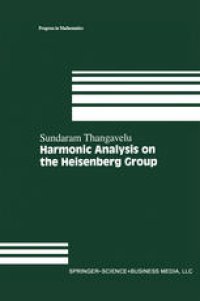
Ebook: Harmonic Analysis on the Heisenberg Group
Author: Sundaram Thangavelu (auth.)
- Tags: Abstract Harmonic Analysis, Group Theory and Generalizations
- Series: Progress in Mathematics 159
- Year: 1998
- Publisher: Birkhäuser Basel
- Edition: 1
- Language: English
- pdf
The Heisenberg group plays an important role in several branches of mathematics, such as representation theory, partial differential equations, number theory, several complex variables and quantum mechanics. This monograph deals with various aspects of harmonic analysis on the Heisenberg group, which is the most commutative among the non-commutative Lie groups, and hence gives the greatest opportunity for generalizing the remarkable results of Euclidean harmonic analysis. The aim of this text is to demonstrate how the standard results of abelian harmonic analysis take shape in the non-abelian setup of the Heisenberg group.
Several results in this monograph appear for the first time in book form, and some theorems have not appeared elsewhere. The detailed discussion of the representation theory of the Heisenberg group goes well beyond the basic Stone-von Neumann theory, and its relations to classical special functions is invaluable for any reader interested in this group. Topic covered include the Plancherel and Paley—Wiener theorems, spectral theory of the sublaplacian, Wiener-Tauberian theorems, Bochner—Riesz means and multipliers for the Fourier transform.
Thangavelu’s exposition is clear and well developed, and leads to several problems worthy of further consideration. Any reader who is interested in pursuing research on the Heisenberg group will find this unique and self-contained text invaluable.
The Heisenberg group plays an important role in several branches of mathematics, such as representation theory, partial differential equations, number theory, several complex variables and quantum mechanics. This monograph deals with various aspects of harmonic analysis on the Heisenberg group, which is the most commutative among the non-commutative Lie groups, and hence gives the greatest opportunity for generalizing the remarkable results of Euclidean harmonic analysis. The aim of this text is to demonstrate how the standard results of abelian harmonic analysis take shape in the non-abelian setup of the Heisenberg group.
Several results in this monograph appear for the first time in book form, and some theorems have not appeared elsewhere. The detailed discussion of the representation theory of the Heisenberg group goes well beyond the basic Stone-von Neumann theory, and its relations to classical special functions is invaluable for any reader interested in this group. Topic covered include the Plancherel and Paley—Wiener theorems, spectral theory of the sublaplacian, Wiener-Tauberian theorems, Bochner—Riesz means and multipliers for the Fourier transform.
Thangavelu’s exposition is clear and well developed, and leads to several problems worthy of further consideration. Any reader who is interested in pursuing research on the Heisenberg group will find this unique and self-contained text invaluable.
The Heisenberg group plays an important role in several branches of mathematics, such as representation theory, partial differential equations, number theory, several complex variables and quantum mechanics. This monograph deals with various aspects of harmonic analysis on the Heisenberg group, which is the most commutative among the non-commutative Lie groups, and hence gives the greatest opportunity for generalizing the remarkable results of Euclidean harmonic analysis. The aim of this text is to demonstrate how the standard results of abelian harmonic analysis take shape in the non-abelian setup of the Heisenberg group.
Several results in this monograph appear for the first time in book form, and some theorems have not appeared elsewhere. The detailed discussion of the representation theory of the Heisenberg group goes well beyond the basic Stone-von Neumann theory, and its relations to classical special functions is invaluable for any reader interested in this group. Topic covered include the Plancherel and Paley—Wiener theorems, spectral theory of the sublaplacian, Wiener-Tauberian theorems, Bochner—Riesz means and multipliers for the Fourier transform.
Thangavelu’s exposition is clear and well developed, and leads to several problems worthy of further consideration. Any reader who is interested in pursuing research on the Heisenberg group will find this unique and self-contained text invaluable.
Content:
Front Matter....Pages i-xiii
The Group Fourier Transform....Pages 1-48
Analysis of the Sublaplacian....Pages 49-107
Group Algebras and Applications....Pages 109-154
The Reduced Heisenberg Group....Pages 155-183
Back Matter....Pages 185-194
The Heisenberg group plays an important role in several branches of mathematics, such as representation theory, partial differential equations, number theory, several complex variables and quantum mechanics. This monograph deals with various aspects of harmonic analysis on the Heisenberg group, which is the most commutative among the non-commutative Lie groups, and hence gives the greatest opportunity for generalizing the remarkable results of Euclidean harmonic analysis. The aim of this text is to demonstrate how the standard results of abelian harmonic analysis take shape in the non-abelian setup of the Heisenberg group.
Several results in this monograph appear for the first time in book form, and some theorems have not appeared elsewhere. The detailed discussion of the representation theory of the Heisenberg group goes well beyond the basic Stone-von Neumann theory, and its relations to classical special functions is invaluable for any reader interested in this group. Topic covered include the Plancherel and Paley—Wiener theorems, spectral theory of the sublaplacian, Wiener-Tauberian theorems, Bochner—Riesz means and multipliers for the Fourier transform.
Thangavelu’s exposition is clear and well developed, and leads to several problems worthy of further consideration. Any reader who is interested in pursuing research on the Heisenberg group will find this unique and self-contained text invaluable.
Content:
Front Matter....Pages i-xiii
The Group Fourier Transform....Pages 1-48
Analysis of the Sublaplacian....Pages 49-107
Group Algebras and Applications....Pages 109-154
The Reduced Heisenberg Group....Pages 155-183
Back Matter....Pages 185-194
....